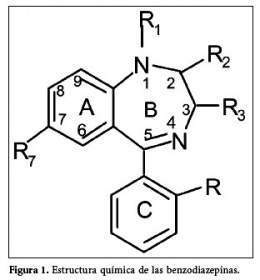Psychotropic drugs that depress the central nervous system . Antidote, uses, adverse side effects and indications.
Benzodiazepines are a type of drug that is very commonly used in the Western world, both for their efficacy, safety and low price. Currently, more than ten types of benzodiazepines can be found, all of them with different pharmacokinetic characteristics. It should be noted that, although it can cause dependence, it is a safe drug even in high doses. Death from an overdose from benzodiazepines is very rare. The first benzodiazepine was chlordiazepoxide. Its discovery, in 1949, is due to the scientist Leo Sternbach. In 1955 it would be synthesized to be marketed two years later under the name Librium by Roche laboratories. Diazepam would later be marketed under the name Valium.

Classification of benzodiazepines
Ultra-short duration compounds, with a half-life of less than 6 hours: rotizolam. Short-lived compounds with a half-life of less than 12 hours: alprazolam, lorazepam. Intermediate compounds, with a half-life between 12 and 24 hours: clonazepam, bromazepam. Long-acting compounds with a half-life greater than 12 hours: diazepam, clobazam, flurazepam.
Characteristics of benzodiazepines
Benzodiazepines provide different possibilities in terms of their therapeutic application. Although, qualitatively, their effects are similar, quantitatively speaking there are important differences, both in terms of their pharmacodynamic spectra and their pharmacokinetic properties. Its main effects are anxiolytics, sedatives, hypnotics, anticonvulsants and muscle relaxants.
Pharmacological use and effects of benzodiazepines
Taking into account these characteristics, they are used to treat problems of anxiety, insomnia, alcohol withdrawal, muscle spasms or epilepsies. In some cases, when it comes to invasive procedures that can cause anxiety in the patient, as in the case of endoscopies or dental interventions, they are used to induce sedation and anesthesia. Benzodiazepines are also commonly used to treat panic disorders caused by hallucinogen poisoning. In its administration in patients diagnosed with anxiety associated with depressive symptoms, its efficacy is not clear, at least in terms of the central aspects of severe major depression, with the most favorable reactions being when it comes to relatively acute manifestations of anxiety.
Benzodiazepines can be useful in the cases of patients in the Intensive Care Unit and who are connected to an artificial respiration device. Also in those patients with pain or who show high tension. Benzodiazepines are also widely used in veterinary practice, applied to various disorders.
Benzodiazepine poisoning
Dependence on these drugs, broadly speaking, comprises two groups. On the one hand, there are patients who can potentially develop this dependence, such as people with personality disorders or those with a history of sedative or alcohol abuse. On the other hand, there are people who use, or rather, abuse benzodiazepines for recreational purposes. Its effect on the activation of the central nervous system’s dopaminergic gratification pathways causes an addictive effect, developing a high tolerance and creating a physical and psychological dependence. To this must be added a high risk of creating a significant withdrawal syndrome, particularly with temazepam. This drug is sometimes used intravenously,
Antidote to benzodiazepines
The indicated antidote for a benzodiazepine overdose is flumazenil, whose use is recommended in those cases in which coma and secondary respiratory depression associated with the use of this drug occur, a situation that is very rare. However, it should be noted that flumazenil also carries certain risks, which is why its use should be restricted only in those cases where it is essential. The risks, especially, are higher in those patients who present hypotension, arrhythmias or hemodynamic alterations. In patients with a history of epileptic episodes, it can be a trigger for seizures. In any case, the use of flumazenil is unnecessary in most cases.
